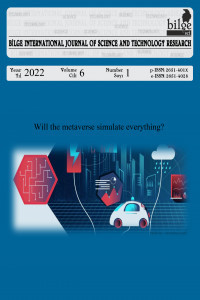Simulation of Load Behavior Based on Perturb-Observation Method in Non-Isolated Boost Converter for Maximum Power Point Tracking of Thermoelectric Generators
Simulation of Load Behavior Based on Perturb-Observation Method in Non-Isolated Boost Converter for Maximum Power Point Tracking of Thermoelectric Generators
Thermoelectric generator MPPT, Boost converter, Load limit,
___
- Ahmad, M. E., Numan, A. H., Mahmood, D. Y. (2022). A comparative study of perturb and observe (P&O) and incremental conductance (INC) PV MPPT techniques at different radiation and temperature conditions. Engineering and Technology Journal, 40(02), 376-385. http://doi.org/10.30684/etj.v40i2.2189
- Al-Diab, A., Sourkounis, C. (2010, May). Variable step size P&O MPPT algorithm for PV systems. In 2010 12th International conference on optimization of electrical and electronic equipment (pp. 1097-1102). IEEE. http://doi.org/10.1109/OPTIM.2010.5510441
- Armin Razmjoo, A., Sumper, A., Davarpanah, A. (2020). Energy sustainability analysis based on SDGs for developing countries. Energy Sources, Part A: Recovery, Utilization, and Environmental Effects, 42(9), 1041-1056. http://doi.org/10.1080/15567036.2019.1602215
- Attar, A., Lee, H., Snyder, G. J. (2020). Optimum load resistance for a thermoelectric generator system. Energy Conversion and Management, 226, 113490. http://doi.org/10.1016/j.enconman.2020.113490
- Benhadouga, S., Meddad, M., Eddiai, A., Boukhetala, D., Khenfer, R. (2019). Sliding Mode Control for MPPT of a Thermogenerator. Journal of Electronic Materials, 48, 2103-2111. https://doi.org/10.1007/s11664-019-06997-y
- Bijukumar, B., Raam, A. G. K., Ganesan, S. I., Nagamani, C., Reddy, M. J. B. (2019). MPPT algorithm for thermoelectric generators based on parabolic extrapolation. IET Generation, Transmission & Distribution, 13(6), 821-828. http://doi.org/10.1049/iet-gtd.2017.2007
- Bhuiyan, M. R. A., Mamur, H., Üstüner, M. A., Dilmaç, Ö. F., (2022). Current and future trend opportunities of thermoelectric generator applications in waste heat recovery. Gazi University Journal of Science, 896-915. http://doi.org/10.35378/gujs.934901
- Bond, M., Park, J. D. (2015). Current-sensorless power estimation and MPPT implementation for thermoelectric generators. IEEE Transactions on Industrial Electronics, 62(9), 5539-5548. http://doi.org/10.1109/TIE.2015.2414393
- Dileep, G., Singh, S. N. (2017). Selection of non-isolated DC-DC converters for solar photovoltaic system. Renewable and Sustainable Energy Reviews, 76, 1230-1247. http://doi.org/10.1016/j.rser.2017.03.130
- Jouhara, H., Khordehgah, N., Almahmoud, S., Delpech, B., Chauhan, A., Tassou, S. A. (2018). Waste heat recovery technologies and applications. Thermal Science and Engineering Progress, 6, 268-289. http://doi.org/10.1016/j.tsep.2018.04.017
- Khan, M. K., Zafar, M. H., Mansoor, M., Mirza, A. F., Khan, U. A., & Khan, N. M. (2022). Green energy extraction for sustainable development: A novel MPPT technique for hybrid PV-TEG system. Sustainable Energy Technologies and Assessments, 53, 102388. https://doi.org/10.1016/j.seta.2022.102388
- Mamur, H., Ahiska, R. (2015). Application of a DC–DC boost converter with maximum power point tracking for low power thermoelectric generators. Energy conversion and management, 97, 265-272. http://doi.org/10.1016/j.enconman.2015.03.068
- Mamur, H., Coban, Y. (2020a). Detailed modeling of a thermoelectric generator for maximum power point tracking. Turkish Journal of Electrical Engineering & Computer Sciences, 28(1), 124-139. http://doi.org/10.3906/elk-1907-166
- Mamur, H., Çoban, Y. (2020b). Termoelektrik jeneratörler için alçaltan-yükselten çeviricili maksimum güç noktası takibi benzetimi. Pamukkale Üniversitesi Mühendislik Bilimleri Dergisi, 26(5), 916-926. http://doi.org/10.5505/pajes.2019.92488
- Mamur, H., Dilmaç, Ö. F., Begum, J., Bhuiyan, M. R. A. (2021). Thermoelectric generators act as renewable energy sources. Cleaner Materials, 2, 100030.
- Mamur, H., Üstüner, M. A. (2021) Improved perturb and observe maxımum power poınt trackıng method wıth thermoelectrıc generator model. International Scientific Conferance, Gabrova.
- Mamur, H., Üstüner, M. A., Bhuiyan, M. R. A., (2022). Future perspective and current situation of maximum power point tracking methods in thermoelectric generators. Sustainable Energy Technologies and Assessments, 50, 101824. http://doi.org/10.1016/j.clema.2021.100030
- Montecucco, A., Knox, A. R. (2014). Maximum power point tracking converter based on the open-circuit voltage method for thermoelectric generators. IEEE Transactions on Power Electronics, 30(2), 828-839. http://doi.org/10.1109/TPEL.2014.2313294
- Pilakkat, D., Kanthalakshmi, S. (2019). An improved P&O algorithm integrated with artificial bee colony for photovoltaic systems under partial shading conditions. Solar Energy, 178, 37-47. http://doi.org/10.1016/j.solener.2018.12.008
- Sarbu, I., Sebarchievici, C. (2018). A comprehensive review of thermal energy storage. Sustainability, 10(1), 191. http://doi.org/10.3390/su10010191
- Taghvaee, M. H., Radzi, M. A. M., Moosavain, S. M., Hizam, H., Marhaban, M. H., (2013). A current and future study on non-isolated DC–DC converters for photovoltaic applications. Renewable and Sustainable Energy Reviews, 17, 216-227. http://doi.org/10.1016/j.rser.2012.09.023
- Tsai, H. L., Lin, J. M. (2010). Model building and simulation of thermoelectric module using Matlab/Simulink. Journal of Electronic Materials, 39(9), 2105. http://doi.org/10.1007/s11664-009-0994-x
- Qasim, A. M., Alwan, T. N., PraveenKumar, S., Velkin, V. I., Agyekum, E. B. (2021). A New maximum power point tracking technique for thermoelectric generator modules. Inventions, 6(4), 88. http://doi.org/10.3390/inventions6040088
- Mamur, H., Çiğdem, A., Üstüner, M.A. (2022, Sep). Investigation of Load Dependent Behavior of Boost Converter with Perturb and Observe Maximum Power Point Tracking for Thermoelectric Generators, In International Conferences on Science and Technology Engineering Sciences and Technology (ICONST EST 2022).
- Zafar, M. H., Khan, N. M., Mansoor, M., & Khan, U. A. (2022). Towards green energy for sustainable development: Machine learning based MPPT approach for thermoelectric generator. Journal of Cleaner Production, 351, 131591. https://doi.org/10.1016/j.jclepro.2022.131591
- ISSN: 2651-401X
- Yayın Aralığı: Yılda 2 Sayı
- Başlangıç: 2017
- Yayıncı: Kutbilge Akademisyenler Derneği
Mustafa TOSUN, Sait Dündar SOFUOĞLU
Characterization Of Soil For Road Shoulders Mixed With Reclaimed Asphalt Pavement Waste
Saber Shah SABERİ, Azman MOHAMED
Hana ĎÚRANOVÁ, Veronika VALKOVÁ, Lucia GALOVİČOVÁ, Nenad VUKOVİC, Milena VUKİC, Miroslava KAČÁNİOVÁ
Antifungal Efficacy of Mint Essential Oil Against Penicillium spp. Inoculated on Carrots
Veronika VALKOVÁ, Hana ĎÚRANOVÁ, Lucia GALOVİČOVÁ, Nenad VUKOVİC, Milena VUKİC, Miroslava KAČÁNİOVÁ
Climate Change Will Cause a Pollination Crisis in the Mediterranean Basin
Antibacterial activity of the vapor phase of Thymus mastichina essential oil
Lucia GALOVİČOVÁ, Natália ČMİKOVÁ, Veronika VALKOVÁ, Miroslava KAČÁNİOVÁ
Evaluation of the Warehouse Location Alternatives for Possible Great Istanbul Earthquake
Asli Gul YALCİNDAG, Mehtap DURSUN, Nazlı GOKER
Characteristics Of Some Warm Climate Grass Plants Commonly Used In Green Field Plant
Realization of a Bionic Hand Controlled via Bluetooth Communication Utilizing a Microcontroller
